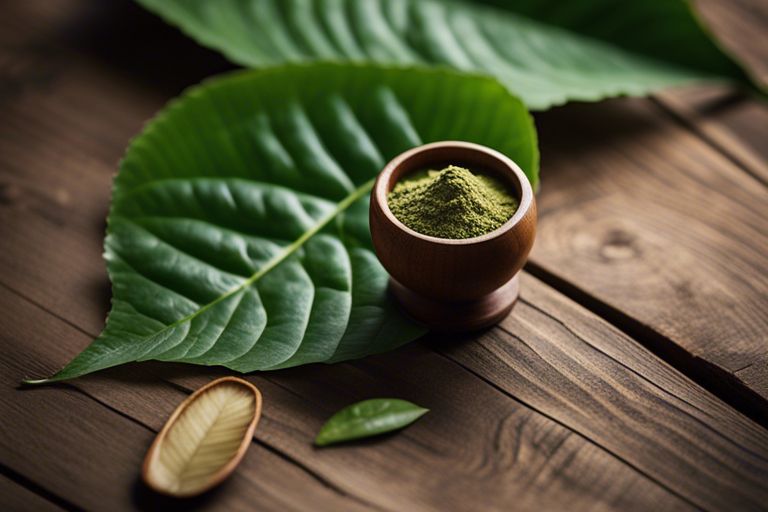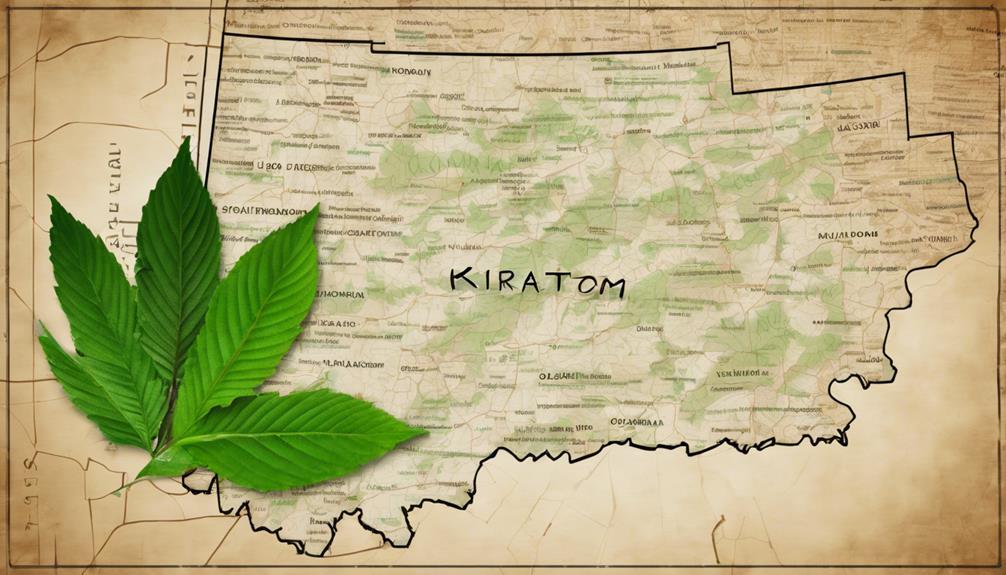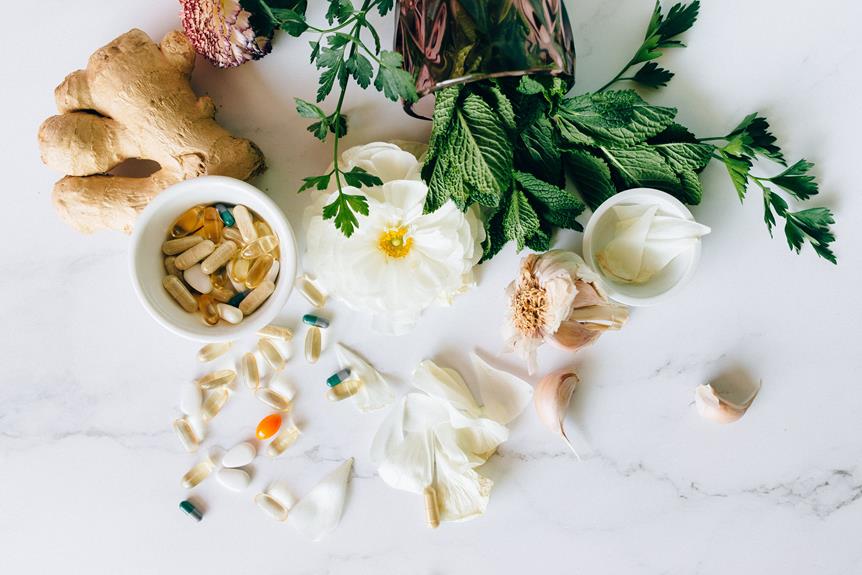Kava, a revered ceremonial drink in the South Pacific, and kratom, a controversial herb gaining popularity for its alleged health benefits, are two fascinating botanicals with unique properties worth exploring. While kratom’s potential for addiction and liver damage raises concerns, its pain-relieving and mood-boosting properties are undeniable. On the other hand, kava is praised for its calming effects, but its link to liver toxicity urges caution. Understanding the risks and benefits of these natural remedies is crucial for making informed decisions about incorporating them into your health routine.
Key Takeaways:
- Kratom Leaf: Kratom leaf, often used for its medicinal properties in traditional medicine, contains alkaloids that can act as both stimulants and sedatives, providing potential pain relief and mood enhancement.
- Kava Root: Kava root, originating from the South Pacific, is known for its calming effects and is used to reduce anxiety and stress, promoting relaxation without cognitive impairment.
- Usage: While both kratom leaf and kava root offer various health benefits, it’s crucial to use them responsibly and in moderation to avoid potential side effects or dependency issues.
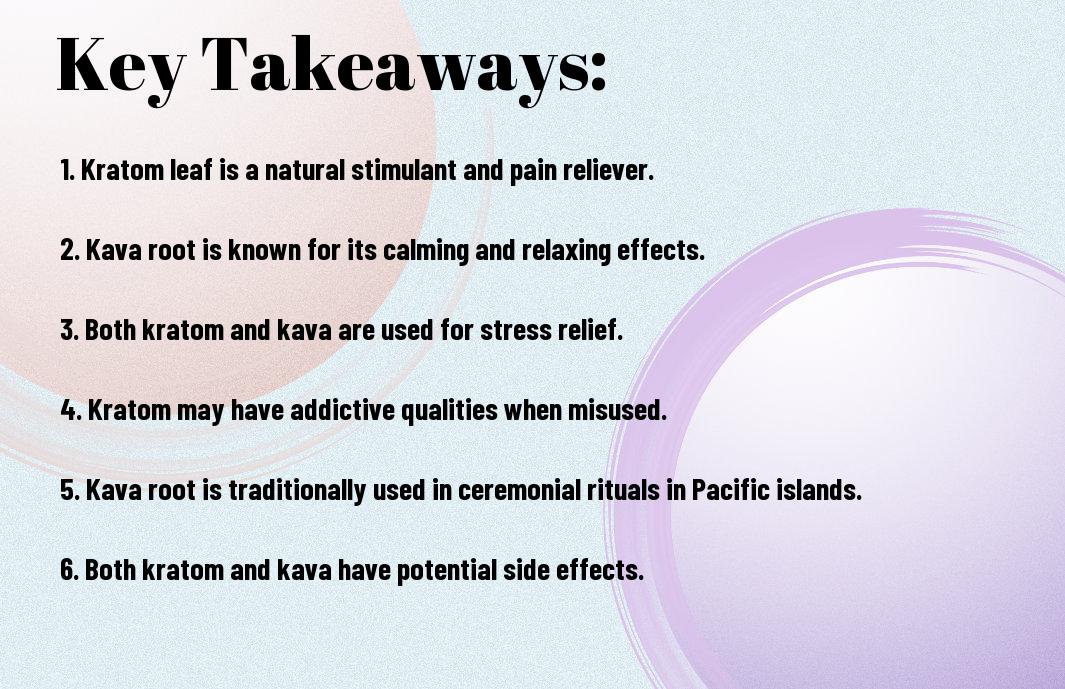
History and Origins
Kratom Leaf: A Brief History
The history of kratom leaf dates back centuries and is deeply rooted in Southeast Asian cultures. Known scientifically as Mitragyna speciosa, this evergreen tree has been used for its medicinal properties in countries like Thailand, Indonesia, and Malaysia. Traditionally, kratom was brewed into teas or consumed raw by laborers and farmers to combat fatigue, boost energy levels, and manage pain.
Kava Root: Ancient Traditions
The traditional use of kava root can be traced back thousands of years to the Pacific islands, where it holds significant cultural and spiritual significance. For centuries, Pacific Islanders have utilized kava root in ceremonial rituals, social gatherings, and medicinal practices. For instance, kava has been traditionally consumed to promote relaxation, reduce anxiety, and induce a sense of euphoria.
Botany and Chemistry
Kratom Leaf: Alkaloid Composition
With a botanical name of Mitragyna speciosa, the kratom leaf is a fascinating specimen known for its diverse alkaloid composition. The most notable alkaloids present in kratom leaves are mitragynine and 7-hydroxymitragynine, which are responsible for the plant’s effects on the human body. These alkaloids interact with opioid receptors in the brain, leading to pain relief, sedation, and mood enhancement. However, it’s vital to note that kratom also contains other alkaloids that contribute to its overall pharmacological profile.
Kava Root: Piper Methysticum Breakdown
Piper Methysticum, commonly known as kava root, is a plant native to the Pacific Islands, revered for its calming and anxiety-reducing properties. The key components in kava root are kavalactones, which are responsible for the plant’s psychoactive effects. Through their interaction with neurotransmitters in the brain, kavalactones induce a sense of relaxation and well-being in individuals who consume kava. However, it’s crucial to consume kava in moderation as excessive intake can lead to liver toxicity.
To investigate deeper into the chemistry of kava root, it’s important to highlight that different cultivars of the plant may contain varying levels of kavalactones. Factors such as the age of the plant, the part of the plant used, and the method of preparation can all influence the concentration of kavalactones in the final product. This variability underscores the importance of sourcing high-quality kava products from reputable suppliers to ensure a safe and beneficial experience.
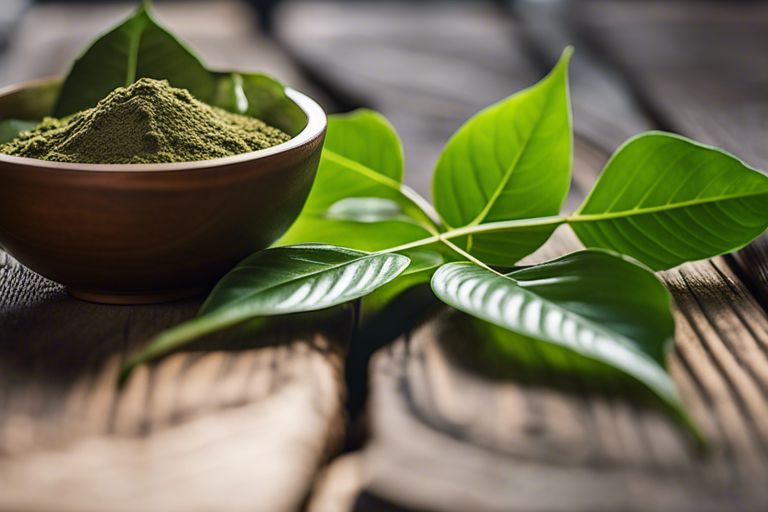
Traditional Uses
Kratom Leaf: Folk Medicine in Southeast Asia
For centuries, kratom leaf has been used as a traditional folk medicine in Southeast Asia. The indigenous people of regions like Thailand, Malaysia, and Indonesia have long utilized kratom for its medicinal properties. It has been used to help manage pain, boost energy levels, and alleviate fatigue. Kratom has also been known to aid in relaxation and provide a sense of well-being.
Kava Root: Ceremonial Significance in the Pacific Islands
Medicine as well as a ceremonial beverage in the Pacific Islands, kava root holds significant cultural importance. In rituals and social gatherings, the preparation and consumption of kava are central to the community’s traditions. The root is known for its sedative effects and is used to promote relaxation, enhance sociability, and induce a sense of calmness among individuals during ceremonies.
Modern Applications
Kratom Leaf: Pain Relief and Opiate Withdrawal
Keep in mind that while kratom leaf is known for its potential pain-relieving properties, its effectiveness can vary from person to person. Some individuals use kratom as a natural alternative to manage chronic pain conditions, such as arthritis or back pain. Others have reported success in using kratom to alleviate symptoms of opiate withdrawal. This is due to kratom’s interaction with opioid receptors in the brain, which can help reduce cravings and withdrawal symptoms.
Kava Root: Anxiety and Stress Relief
To address symptoms of anxiety and stress, individuals have turned to kava root for its potential calming effects. Kava contains compounds called kavalactones, which are believed to interact with neurotransmitters in the brain to promote relaxation and reduce anxiety. With its tranquilizing properties, kava has been traditionally used in Pacific Island cultures for ceremonies and social gatherings, where it is consumed as a drink to induce a sense of calm and euphoria.
Understanding the effects of kava root is vital, as excessive consumption or prolonged use may lead to negative outcomes. Reports suggest that heavy kava consumption over extended periods can potentially cause liver damage. It is important to use kava root responsibly and in moderation to reap its benefits for anxiety and stress relief.
Effects and Interactions
Despite Kava vs. Kratom | The Important Differences – Leilo, the effects of kratom leaf and kava root are quite distinct. Understanding these differences is crucial for individuals incorporating these botanicals into their wellness routines.
Kratom Leaf: Stimulating and Sedating Properties
Any discussion about kratom leaf must acknowledge its dual nature, as it possesses both stimulating and sedating properties. Depending on the dosage and individual response, kratom can act as a stimulant, boosting energy, focus, and sociability. However, at higher doses, it can also induce sedative effects, promoting relaxation and potentially aiding in pain relief.
Kava Root: Potential Interactions with Medications
Sedating and calming, kava root is renowned for its potential interactions with medications. It’s necessary for individuals considering kava supplementation to be aware of the potential risks involved, especially when combined with substances such as alcohol, benzodiazepines, or medications affecting the liver. Interactions with these substances can be dangerous and should be approached with caution.
Avoiding these interactions is crucial, as they can lead to unexpected side effects, decreased efficacy of medications, or even liver damage in severe cases. Always consult with a healthcare professional before incorporating kava into your wellness regimen, especially if you are currently taking medications or have underlying health conditions.
Safety and Regulations
Kratom Leaf: Controversies and Legal Status
Many controversies surround Kratom leaf due to its potential for addiction and dependence. While some people praise its pain-relieving and energizing effects, others are concerned about the risks associated with its use. In the United States, Kratom is legal in some states but banned in others, leading to a patchwork of regulations that can be confusing for consumers.
Kava Root: FDA Warnings and Restrictions
For Kava root, the FDA has issued warnings about the potential risks of liver damage associated with its consumption. The FDA has also placed restrictions on the sale of Kava products due to these safety concerns. It is important for consumers to be aware of these warnings and to use Kava root products cautiously.
To ensure safety when consuming Kava root, it is crucial to purchase products from reputable sources and follow recommended dosages. Consulting with a healthcare provider before using Kava root can also help mitigate potential health risks.
What are the differences between kratom leaf and kava root?
When conducting a kava vs kratom comparison, it’s essential to understand the differences between kratom leaf and kava root. Kratom leaf is known for its stimulant effects, while kava root is popular for its sedative properties. Additionally, kratom is often used for pain relief, while kava is used for anxiety and stress relief.
Final Words
Summing up, kratom leaf and kava root are two fascinating plants with unique properties that have been valued for centuries in traditional cultures. While each plant has its distinct effects and benefits, it is vital to understand how they may interact if consumed together. For further insights on the topic, you can explore Can You Mix Kava and Kratom Together? for a deeper understanding of the potential synergy or risks associated with combining these two botanicals.
FAQ
Q: What is Kratom Leaf?
A: Kratom Leaf comes from the Mitragyna speciosa tree native to Southeast Asia. It is known for its stimulant and sedative properties, depending on the dosage.
Q: What is Kava Root?
A: Kava Root is derived from the Piper methysticum plant, indigenous to the South Pacific islands. It is used for its relaxation and anti-anxiety effects.
Q: How is Kratom Leaf consumed?
A: Kratom Leaf can be chewed, brewed into tea, or ingested in capsule form. It is important to follow dosage guidelines to avoid adverse effects.
Q: What are the benefits of Kava Root?
A: Kava Root is known for its calming effects, reducing stress and anxiety. It can also promote relaxation and improve sleep quality.
Q: Are there any risks associated with Kratom and Kava consumption?
A: Both Kratom and Kava can have side effects such as nausea, dizziness, and dependency if abused or used in excess. It is crucial to use them responsibly and in moderation.
